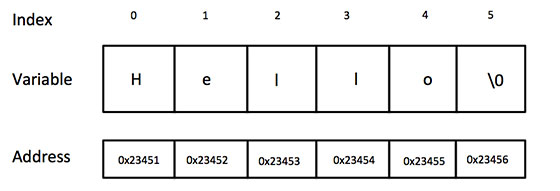c++ 字符串
c++ 提供了以下兩種類型的字符串表示形式:
- c 風(fēng)格字符串
- c++ 引入的 string 類類型
1. c 風(fēng)格字符串
c 風(fēng)格的字符串起源于 c 語(yǔ)言,并在 c++ 中繼續(xù)得到支持。字符串實(shí)際上是使用 null 字符 '' 終止的一維字符數(shù)組。因此,一個(gè)以 null 結(jié)尾的字符串,包含了組成字符串的字符。
下面的聲明和初始化創(chuàng)建了一個(gè) "hello" 字符串。由于在數(shù)組的末尾存儲(chǔ)了空字符,所以字符數(shù)組的大小比單詞 "hello" 的字符數(shù)多一個(gè)。char greeting[6] = {'h', 'e', 'l', 'l', 'o', ''};
依據(jù)數(shù)組初始化規(guī)則,您可以把上面的語(yǔ)句寫成以下語(yǔ)句:
char greeting[] = "hello";
以下是 c/c++ 中定義的字符串的內(nèi)存表示:

其實(shí),您不需要把 null 字符放在字符串常量的末尾。c++ 編譯器會(huì)在初始化數(shù)組時(shí),自動(dòng)把 '' 放在字符串的末尾。讓我們嘗試輸出上面的字符串
#include using namespace std;
int main ()
{
char greeting[6] = {'h', 'e', 'l', 'l', 'o', '\0'};
cout << "greeting message: ";
cout << greeting << endl;
return 0;
} 當(dāng)上面的代碼被編譯和執(zhí)行時(shí),它會(huì)產(chǎn)生下列結(jié)果:
greeting message: hello
c++ 中有大量的函數(shù)用來(lái)操作以 null 結(jié)尾的字符串:supports a wide range of functions that manipulate null-terminated strings:
| 序號(hào) | 函數(shù) & 目的 |
|---|---|
| 1 | strcpy(s1, s2); 復(fù)制字符串 s2 到字符串 s1。 |
| 2 | strcat(s1, s2); 連接字符串 s2 到字符串 s1 的末尾。 |
| 3 | strlen(s1); 返回字符串 s1 的長(zhǎng)度。 |
| 4 | strcmp(s1, s2); 如果 s1 和 s2 是相同的,則返回 0;如果 s1s2 則返回大于 0。 |
| 5 | strchr(s1, ch); 返回一個(gè)指針,指向字符串 s1 中字符 ch 的第一次出現(xiàn)的位置。 |
| 6 | strstr(s1, s2); 返回一個(gè)指針,指向字符串 s1 中字符串 s2 的第一次出現(xiàn)的位置。 |
下面的實(shí)例使用了上述的一些函數(shù):
#include #include using namespace std;
int main ()
{
char str1[11] = "hello";
char str2[11] = "world";
char str3[11];
int len ;
// 復(fù)制 str1 到 str3
strcpy( str3, str1);
cout << "strcpy( str3, str1) : " << str3 << endl;
// 連接 str1 和 str2
strcat( str1, str2);
cout << "strcat( str1, str2): " << str1 << endl;
// 連接后,str1 的總長(zhǎng)度
len = strlen(str1);
cout << "strlen(str1) : " << len << endl;
return 0;
} 當(dāng)上面的代碼被編譯和執(zhí)行時(shí),它會(huì)產(chǎn)生下列結(jié)果:
strcpy( str3, str1) : hello strcat( str1, str2): helloworld strlen(str1) : 10
2. c++ 中的 string 類
c++ 標(biāo)準(zhǔn)庫(kù)提供了 string 類類型,支持上述所有的操作,另外還增加了其他更多的功能。我們將學(xué)習(xí) c++ 標(biāo)準(zhǔn)庫(kù)中的這個(gè)類,現(xiàn)在讓我們先來(lái)看看下面這個(gè)實(shí)例:
現(xiàn)在您可能還無(wú)法透徹地理解這個(gè)實(shí)例,因?yàn)榈侥壳盀橹刮覀冞€沒有討論類和對(duì)象。所以現(xiàn)在您可以只是粗略地看下這個(gè)實(shí)例,等理解了面向?qū)ο蟮母拍钪笤倩仡^來(lái)理解這個(gè)實(shí)例。
#include #include using namespace std;
int main ()
{
string str1 = "hello";
string str2 = "world";
string str3;
int len ;
// 復(fù)制 str1 到 str3
str3 = str1;
cout << "str3 : " << str3 << endl;
// 連接 str1 和 str2
str3 = str1 + str2;
cout << "str1 + str2 : " << str3 << endl;
// 連接后,str3 的總長(zhǎng)度
len = str3.size();
cout << "str3.size() : " << len << endl;
return 0;
} 當(dāng)上面的代碼被編譯和執(zhí)行時(shí),它會(huì)產(chǎn)生下列結(jié)果:
str3 : hello str1 + str2 : helloworld str3.size() : 10




